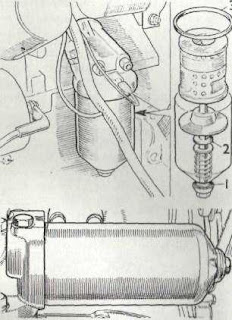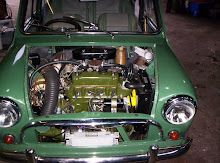The engine oil becomes contaminated with carbon and other products of combustion, including condensed water and fuel, and must, therefore, be drained out at least at 6,000-mile intervals for cars fitted with standard transmissions and at 3,000-mile
Fig. 10. The oil-pressure relief valve
intervals for automatic-transmission models. If the engine is worn, the degree of gas leakage past the piston rings may make it advisable to change the oil more frequently; for example, at 3,000 miles for standard-transmission models and, say, 1,500 miles when an automatic transmission is fitted. Also, more frequent changes are advisable when most of the driving is done in cold weather, particularly when frequent starts are made from cold and when the engine is allowed to idle for long periods. At the other extreme, in hot, dusty conditions the oil will deteriorate more quickly than in temperate climates. Under adverse conditions it may be advisable to change the oil as frequently as every 1,000 miles. If in doubt, consult your local B.L.M.C. dealer.
The oil should be drained when the car has just come in from a run; being hot, it will be more fluid and will be holding in suspension the impurities. At the same time the oil filter element should be cleaned or, preferably, renewed.
If a modern premium oil is used, it should not be necessary to flush out the sump with flushing oil, as was often recommended with older types of car. As the sump may contain up to nine pints of oil, a sufficiently
Fig. 11. The engine oil filter. Above, as fitted to manual-gearbox models. Below, the filter used when an automatic transmission is fitted. The rubber seal, 1 ; felt seal, 2, and the rubber ring, 3, must be in good condition
large drain pan should be provided. An old kitchen washing-up bowl will serve admirably. Sufficient time should be allowed for the oil to drain completely before the drain plug is replaced. The sump should then be refilled until the level is up to the "full" mark on the dipstick.
While the oil is draining, examine the drain plug. This is unusual, as it incorporates a magnet which will attract and hold the minute iron and steel particles that must inevitably be worn off the gears, and which might otherwise damage the engine if the oil filter were allowed to become clogged to such an extent that the filter by-pass valve opened.





0 comments:
Post a Comment